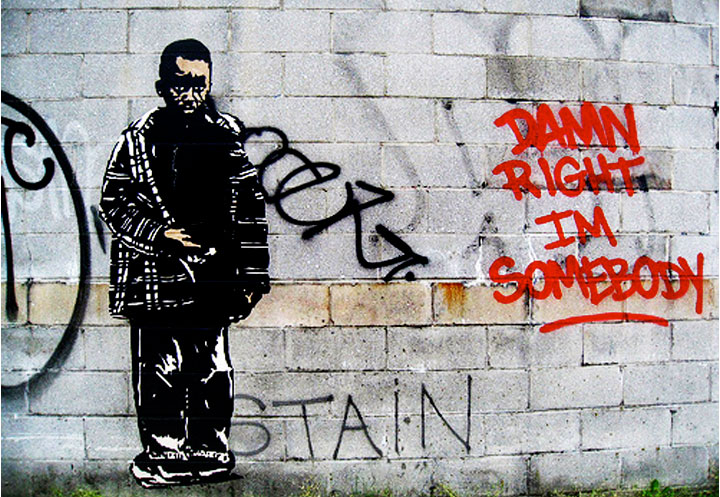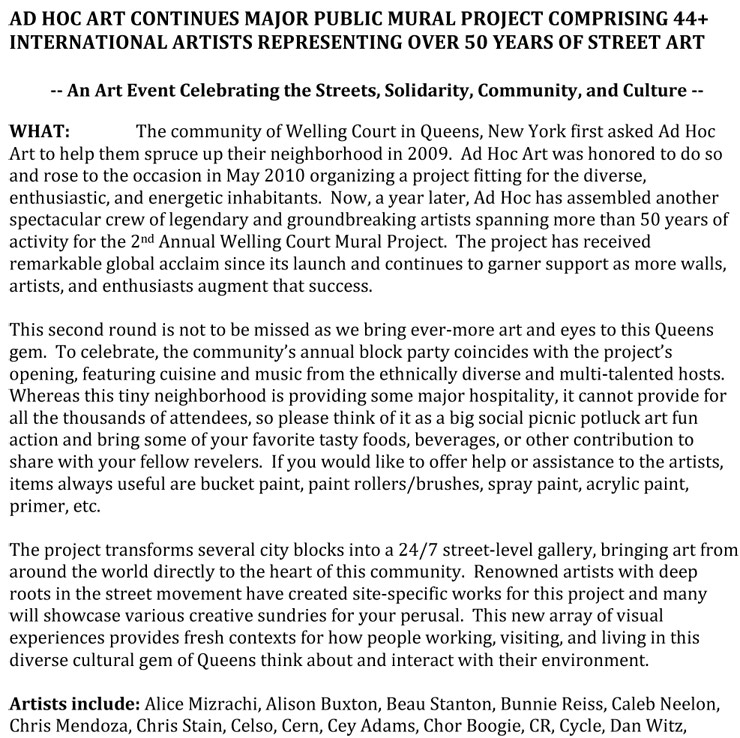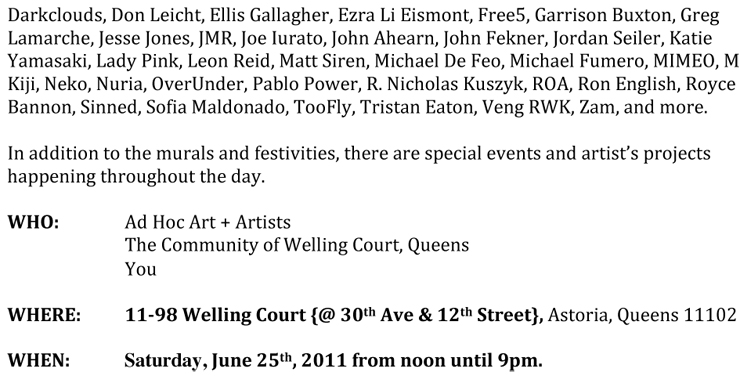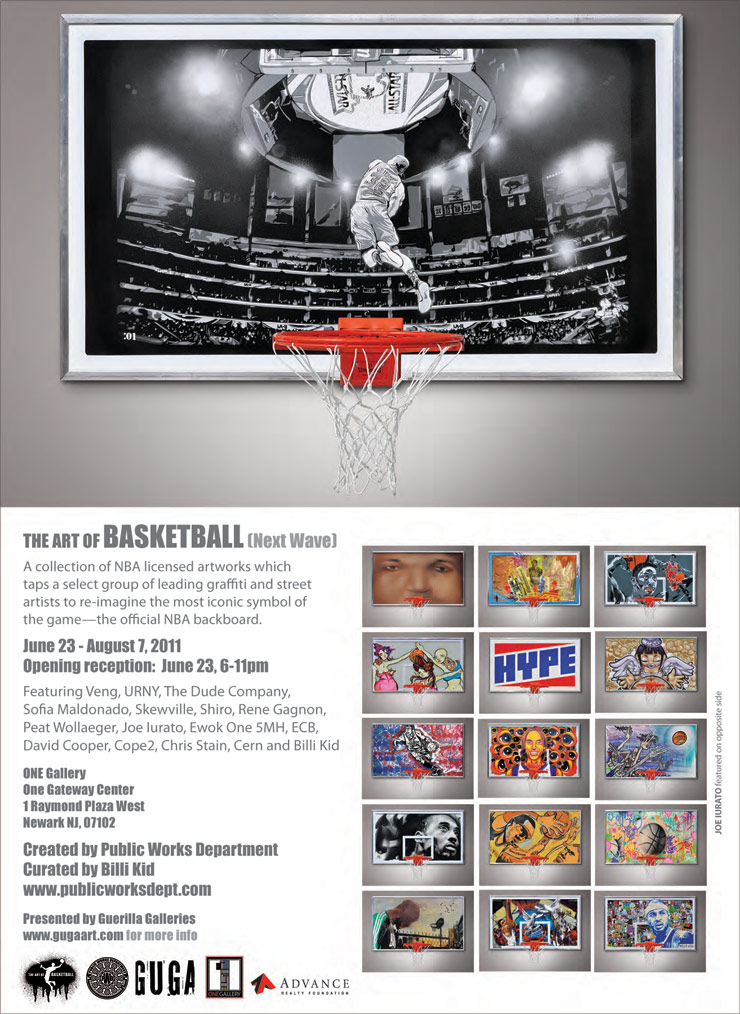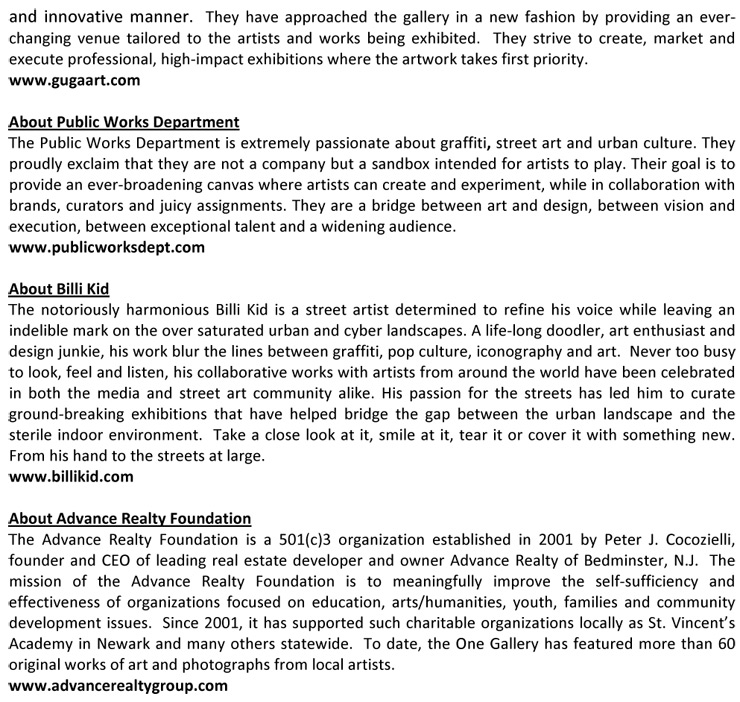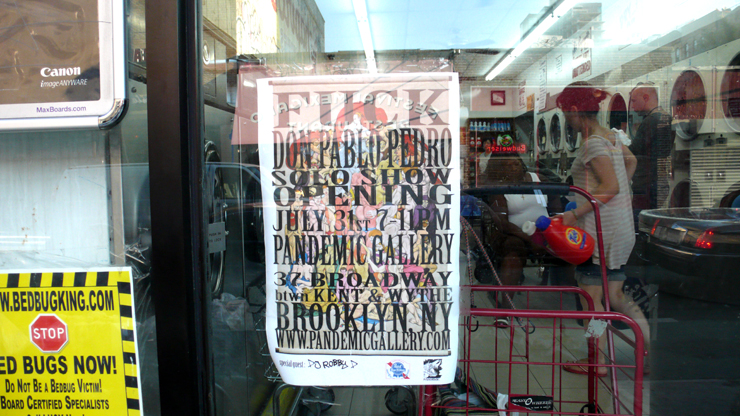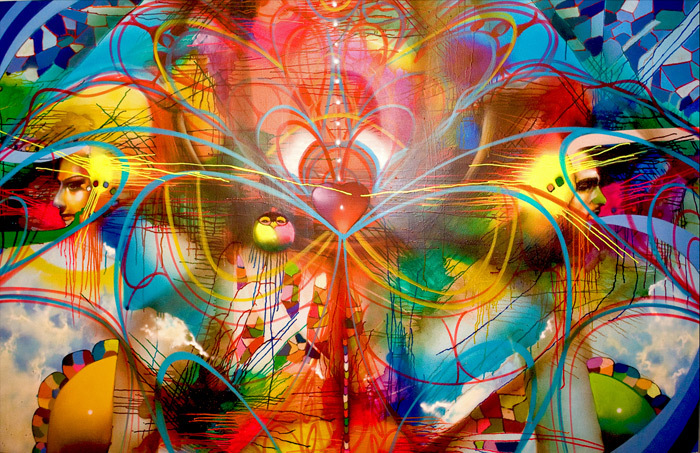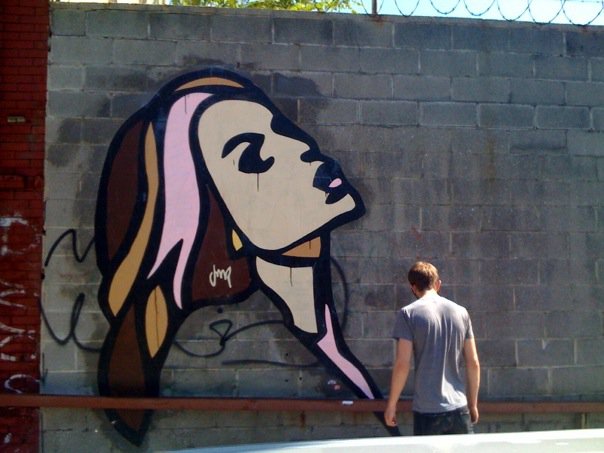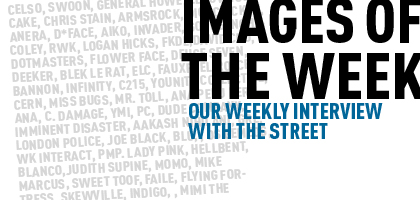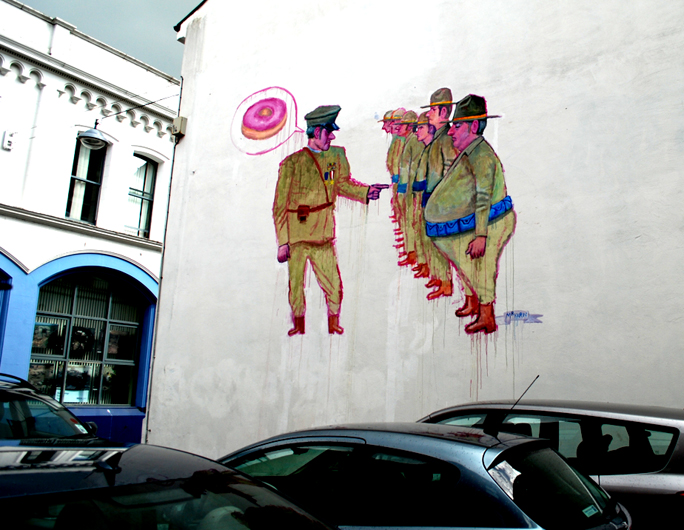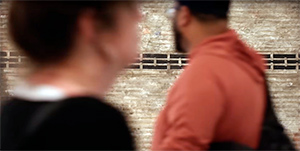Wellng Court
All posts tagged: Cern
Guerrilla Galleries and Billi Kid Present: The Art of Basketball (Next Wave) (Newark, NJ)
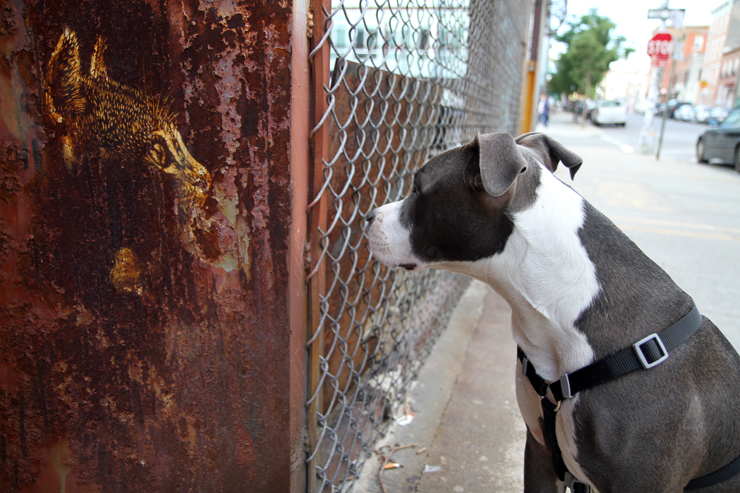
Street Art Photographers: Capturing Ephemera Part 2

We continue with Part 2 of our interview with Becki Fuller, Stefan Kloo, and Luna Park; three Street Art photographers who have reached a certain stature among their peers for their contributions to the scene. As each describes their work and their experiences as documenters and creative artists, one can see that their level of understanding goes beyond merely academic or stenographic while including elements of both. From beginner to expert, there are artists on both side of the camera and the very nature of Street Art provides a forum for each.
Google Maps does a pretty good job at simply documenting streets. These professionals and others like them know how to discern, interpret and present the work of Street Artists in ways that can add context, meaning, breath and life. We heartily thank these three artists for their candid and insightful responses (and incisive wit!) and we look forward to including many other voices in the ongoing discovery that is Street Art today.

C215 © Becki Fuller
Brooklyn Street Art: Five years ago the act of documenting pieces by street artists was the work of a relative handful of photographers. Thanks to new technology there are more photographers today documenting it and some Street Artists document their own work, posting images on their personal Flickr pages and web sites before the photographers get to them. How do you feel about this and does it change your view of your efforts or you view of the artists?
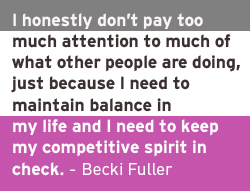 Becki Fuller: I say the more people who are interested in street art enough to document it, the better! But yes, it has definitely changed things. When I first started shooting street art, I easily received a lot of attention just because there was a much smaller group of people who were documenting it and sharing it. And for a while it took some of the fun out of it for me when I realized that people were trading locations with each other or getting them from artists even before the work went up, really turning on the pressure to photograph a piece within hours of its appearance. But I quickly came to terms with what I want to do and what I am willing to do in order to continue enjoying street art photography. I honestly don’t pay too much attention to much of what other people are doing, just because I need to maintain balance in my life and I need to keep my competitive spirit in check.
Becki Fuller: I say the more people who are interested in street art enough to document it, the better! But yes, it has definitely changed things. When I first started shooting street art, I easily received a lot of attention just because there was a much smaller group of people who were documenting it and sharing it. And for a while it took some of the fun out of it for me when I realized that people were trading locations with each other or getting them from artists even before the work went up, really turning on the pressure to photograph a piece within hours of its appearance. But I quickly came to terms with what I want to do and what I am willing to do in order to continue enjoying street art photography. I honestly don’t pay too much attention to much of what other people are doing, just because I need to maintain balance in my life and I need to keep my competitive spirit in check.
As far as the artists themselves photographing their work goes, well, that’s their right…but (with a few exceptions, such as JR) they also tend to reinforce where their talents lie, and it’s not in photography.
Luna Park: Street art has come of age in the era of social media. Thanks to modern technology, everyone is a photographer now and everyone has the tools with which to position himself or herself within the scene and, if desired, promote themselves within the art marketplace. Where there wasn’t a street art media or blogosphere five years ago, there most certainly is now. The speed at which images are disseminated has been amplified and the whole world is watching. That artists photograph and promote their own work is only natural – some do a better job of it than others – and that’s their prerogative. The Internet has an insatiable appetite and it constantly demands more content; as a result, I feel more pressure now than ever to continue to deliver the goods.
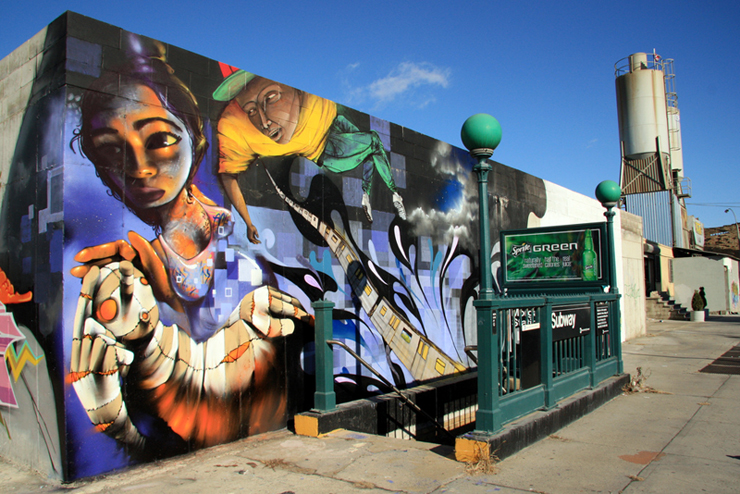
Cern, Cekis, Inti. © Luna Park
There are definitely more players on the documentation field, but I enjoy a little friendly competition, as it motivates me to keep on top of my game. Thanks to my relationships with many artists and my standing in the community, I am often tipped off to the locations of pieces from artists directly or others who share my interests. Five years ago I would have left the house with my camera, without any expectations of what I might find and open to discovery. Sometimes I miss that.
Today I go about following up on leads or hunches much more strategically, all the while ready to adjust my travels around the city as needed. Of course there are still plenty of serendipitous sightings – I revel in every lucky, random encounter. The downside of having achieved a certain level of recognition is that I get a ton of unsolicited email, either from artists eager to introduce me to their work or from PR flacks and marketers desperate to have me shill their products to their target audience. At times it can feel very calculated and cynical, yet by and large I remain unaffected by this type of maneuvering. I am still passionate about street art after all these years and thankful for all the wonderful people that have come into my life because of it. I am never bored, as I constantly have places to go and things to see. My enthusiasm is wholly driven by inspiration and the desire to play it forward.
 Stefan Kloo: I’m absolutely O.K. with others doing the same thing, patrolling the same alleys, getting the same shots. How can you not. It’s like stone soup; it just gets better with everybody contributing the missing ingredient. So you got a better shot, got it first, got the only shot before its gone? What of it? – It’s not a competition! And don’t expect anything in return, most of the artists don’t. If it chaps your hide that someone else got the same shot or got it first, it either means that you’re taking yourself too serious or that you’re a bit of a one trick pony. Just find a different angle, heck find a different subject if your doing it for the approval of others.
Stefan Kloo: I’m absolutely O.K. with others doing the same thing, patrolling the same alleys, getting the same shots. How can you not. It’s like stone soup; it just gets better with everybody contributing the missing ingredient. So you got a better shot, got it first, got the only shot before its gone? What of it? – It’s not a competition! And don’t expect anything in return, most of the artists don’t. If it chaps your hide that someone else got the same shot or got it first, it either means that you’re taking yourself too serious or that you’re a bit of a one trick pony. Just find a different angle, heck find a different subject if your doing it for the approval of others.
The artists deserve props first and are entitled to a “clean take” on their work. We know how fleeting it is and how often a photo is all you got to show for. Whenever possible it’s probably for the better not to rely on others to document your work. Flickr and the blogosphere definitely changed things for me, for the better. Where I used to practically work in a vacuum I now get to flaunt the shots to peers I didn’t know I had. What’s not to like about that?
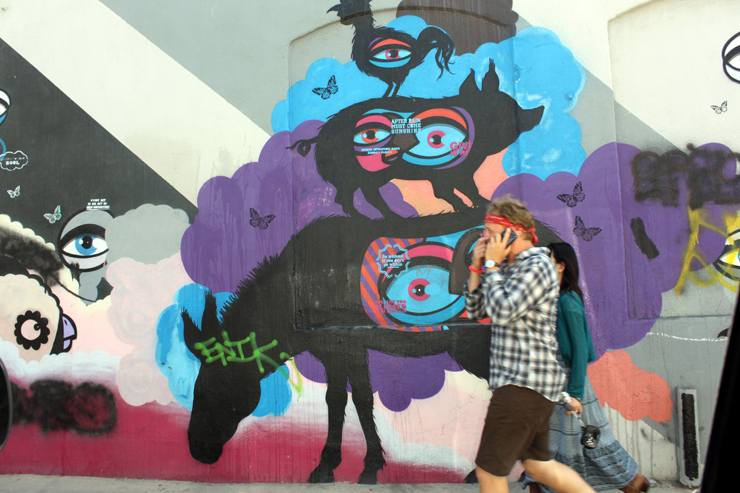
ROA and Chase in Venice, CA. © Stefan Kloo
Brooklyn Street Art: Today there are many websites dedicated to showcasing street art around the world. Many people who run the sites take images and post them without permission or credit to the photographer. What is your opinion of this and should photographers take any action?
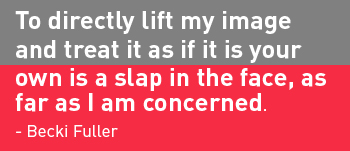 Becki Fuller: Honestly, it really pisses me off when artists or people who should know better do that…I enjoy receiving a nod of recognition for my efforts as much as anyone anywhere does. I spend a lot of time, thought, and money doing what I do, often going into debt just to upgrade my camera or buy a new lens, all without receiving any monetary compensation. I can’t even tell you how many books my photographs have been included in, and it is usually rare for me to receive even so much as a free copy in return. So to directly lift my image and treat it as if it is your own is a slap in the face, as far as I am concerned.
Becki Fuller: Honestly, it really pisses me off when artists or people who should know better do that…I enjoy receiving a nod of recognition for my efforts as much as anyone anywhere does. I spend a lot of time, thought, and money doing what I do, often going into debt just to upgrade my camera or buy a new lens, all without receiving any monetary compensation. I can’t even tell you how many books my photographs have been included in, and it is usually rare for me to receive even so much as a free copy in return. So to directly lift my image and treat it as if it is your own is a slap in the face, as far as I am concerned.
Luna Park: I realize that in putting things online, I open my work up to being stolen, but I still believe the benefits outweigh the risks. It’s unfortunate, but there are unscrupulous sites that continue to post unaccredited photographs, including a few within the larger street art community. I am keenly aware of the pressure to break stories online, but not crediting your sources is just downright disrespectful.
I’ve also encountered an attitude from certain artists who believe that they are not only entitled to dictate what is done with my photographs of their work, but also to freely distribute my photographs without credit. I put a lot of effort into displaying work in the best possible light and always credit artists – it is unfathomable to me that some people think that photographs magically take themselves. I understand that viewers are primarily looking at the artwork depicted, but having a good photograph of it is half the battle. Aside from demanding that credit omissions be rectified, I don’t know what else photographers can do. I am opposed to watermarking, as I find them incredibly distracting. 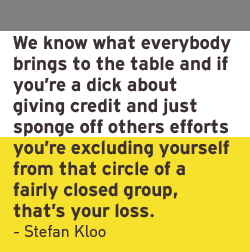
Stefan Kloo: That’s a kick in the taco. You can’t be happy about it. But I don’t think of myself as that important that it warrants a fuzz. I’d like to think that we (street art aficionados) are among friends. We know what everybody brings to the table and if you’re a dick about giving credit and just sponge off others efforts you’re excluding yourself from that circle of a fairly closed group, that’s your loss. It also goes to motive – if you don’t have it in you to credit someone when due, what’s it all about for you then? It’s a lot like having an “assistant” painting or pasting your work – you’re on the outside looking in. If that’s all you got, you’re missing the point. However, the photos should make the rounds, almost regardless of who took the shot.
The art and the artists who created it are the key. Which should not stop you from calling bull on the jockeys and hang them by their nut purse till death is welcome… If anyone makes a buck of a street art photo, two people should get a cut: the artist and the photographer. O.K., and the publisher if you put it in a book. Simple, no? Luckily that’s a dilemma that does not play out very often…
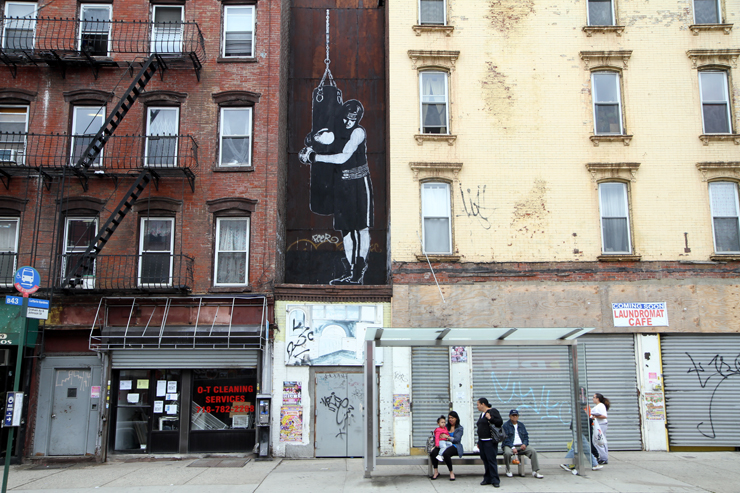
Dolk © Becki Fuller
Brooklyn Street Art: Some art critics have suggested that Street Art enthusiasts, photographers in particular, lack an intellectual and artistic approach to the art that they document and are unable to truly understand Street Art. What’s your opinion on this?
Becki Fuller: At the risk of sounding like a dolt, I don’t think that it is necessary to intellectualize art in order to enjoy it. While a greater understanding of art can definitely enhance your appreciation, I believe that over intellectualizing art leads to a sterile and heartless environment. That’s the main thing that really turned me off from the Chelsea gallery scene in the 2000s and really lead me to Street Art in the first place. Everything seemed so conceptual to the point where you couldn’t enjoy an opening without reading about it first. So I would counter than anyone who believes that you need a PhD in order to appreciate and understand street art probably doesn’t know the first thing about really seeing street art in the first place. 
As far as lacking an artistic approach goes, well, I guess that just depends on the individual. On one hand you have urban photographers such as Nils Müller, Mr. T and Keegan Gibbs. When I look at their photographs, the graffiti/street art becomes secondary to the fact that I am looking at a wicked piece of artwork in its own right. Then you have photographers who become better known for where they have gone, the artwork that they have photographed, and the sheer bulk of what they have to offer. Within this group there are varying levels of artistry, but I would say that all of us do it out of passion and that passion itself can become what is most beautiful about your work.
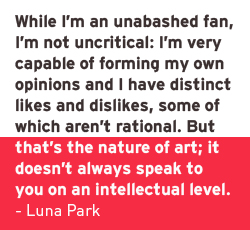 Luna Park: Hogwash. To dismiss all street art photographers as unsophisticated fan boys is an unfair characterization and a gross oversimplification. We are as varied in our backgrounds and talents as the artists whose work we document. In discussing the quality of street art photography, one must differentiate between two issues: the work being documented and the photography itself. Regarding the work being documented, street art photographers are uniquely positioned to recognize trends, chart artistic growth, and identify influences within our own particular street art microcosms. While I’m an unabashed fan, I’m not uncritical: I’m very capable of forming my own opinions and I have distinct likes and dislikes, some of which aren’t rational. But that’s the nature of art; it doesn’t always speak to you on an intellectual level. Astute followers of my photo stream know that what I post is heavily curated, that is, what is missing from my Flickr speaks volumes. I walk past mediocre art on a daily basis; if it doesn’t engage me, I don’t waste time photographing it. If anything, I would say my taste in street art has become decidedly more refined over the years.
Luna Park: Hogwash. To dismiss all street art photographers as unsophisticated fan boys is an unfair characterization and a gross oversimplification. We are as varied in our backgrounds and talents as the artists whose work we document. In discussing the quality of street art photography, one must differentiate between two issues: the work being documented and the photography itself. Regarding the work being documented, street art photographers are uniquely positioned to recognize trends, chart artistic growth, and identify influences within our own particular street art microcosms. While I’m an unabashed fan, I’m not uncritical: I’m very capable of forming my own opinions and I have distinct likes and dislikes, some of which aren’t rational. But that’s the nature of art; it doesn’t always speak to you on an intellectual level. Astute followers of my photo stream know that what I post is heavily curated, that is, what is missing from my Flickr speaks volumes. I walk past mediocre art on a daily basis; if it doesn’t engage me, I don’t waste time photographing it. If anything, I would say my taste in street art has become decidedly more refined over the years.
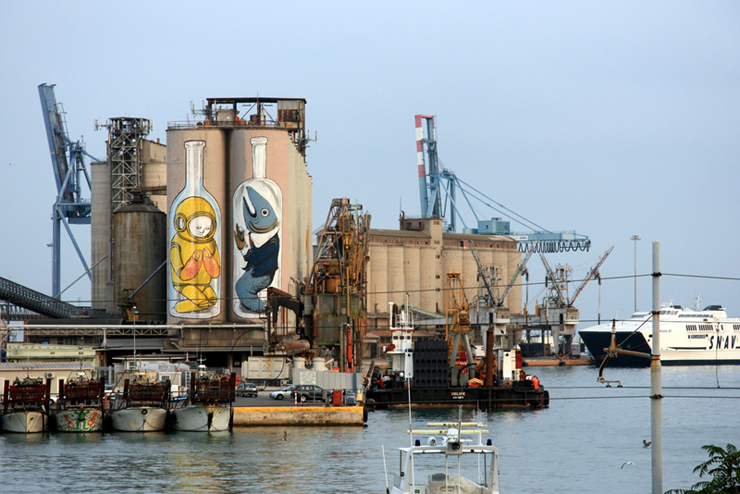
Blu, Erica Il Cane. Anacona, Italy. © Luna Park
Regarding my photography, I believe it too has matured over time. It has long-since been my goal for my photographs to reflect my passion and enthusiasm for street art. I aim to capture work in the best possible light, all the while taking context, materials and possible interpretations into consideration. Over years of observation, I have developed a deep and profound understanding of this incredibly diverse subject matter. I have embraced street art wholeheartedly and internalized it. It has had a pronounced influence on my photography and, as a result, my photography has become my own kind of street art.
Being that I am so close to the subject matter, I am hard pressed to put it into any kind of larger, art historical context. Nor do I necessary see that as my role or responsibility, at least not at this point in time. We are in the midst of a truly global art phenomenon whose parameters have yet to be set. Given the right context and the proper forum, I am willing to engage anyone in an intellectual conversation about the critical merits of street art. In the meantime – and as long as I am in the position to do so – I will continue doing what I love, explore this magnificent, vibrant yet decrepit city, absorb as much amazing art as possible, and create photographs as mementos. And when I run out of steam, maybe I’ll finally sit down and write a book about it one day.
Stefan Kloo: That’s rich…and rather laughable. It’s more the other way around – the trained critic approaches street art mostly with the established criteria his academic training provides. That’s only fair but won’t buy you a drink. In street art it’s about the raw authenticity, the creative kick and the unadulterated pleasure a grievously misguided act of vandalism can provide. If you can’t grasp that a lot of it is simply about mixing things up, you probably should not get on that ride. It’s still a lot about class and that we can’t allow to consolidate the established art world and the slippery street. It’s just snobbery, mostly a vain argument, but it fills the day. I honestly don’t see a conflict between, say, a painting by Poussin or Pollock and a Faile paste or a C215 stencil. In the end it’s how it speaks to you and if there’s a challenge in it for you. Only then do you need to query how relevant it is in terms of cultural anthropology.
What does a critic reply to Banksy’s sentiment “I’m not so interested in convincing people in the art world that what I do is ‘art,’ – I’m more bothered about convincing people in the graffiti community that what I do is really vandalism.” ? Doesn’t that wrap up the whole argument?
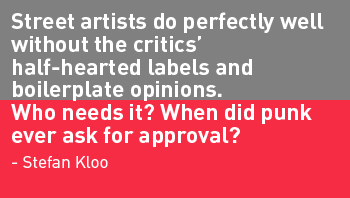 Street art represents a definite paradigm shift in the arts. It’s just a very liberating kick in the ass of bourgeois attitudes towards anything and the arts in particular. Most critics fail to recognize that, and can’t handle the rule bending imposition street art represents. The fact that street art gets by and continues to evolve in theory and practice without the sanctimonious blessing of the art establishment is testimony that the joke’s on them. And we already know how the wine and cheese crowd will speculate the wits out of the genre to buy back their long lost subversive streak and hipness credentials, blissfully oblivious that if you can afford to pay the prices street art commands in the galleries you are all out of street cred and are just buying a commodity. Street artists do perfectly well without the critics’ half-hearted labels and boilerplate opinions. Who needs it? When did punk ever ask for approval?
Street art represents a definite paradigm shift in the arts. It’s just a very liberating kick in the ass of bourgeois attitudes towards anything and the arts in particular. Most critics fail to recognize that, and can’t handle the rule bending imposition street art represents. The fact that street art gets by and continues to evolve in theory and practice without the sanctimonious blessing of the art establishment is testimony that the joke’s on them. And we already know how the wine and cheese crowd will speculate the wits out of the genre to buy back their long lost subversive streak and hipness credentials, blissfully oblivious that if you can afford to pay the prices street art commands in the galleries you are all out of street cred and are just buying a commodity. Street artists do perfectly well without the critics’ half-hearted labels and boilerplate opinions. Who needs it? When did punk ever ask for approval?
<<<> > << > < > < > > <<<>>>>>>BSA<<<> > << > < > < > > <<<>>>>>>BSA
Street Art Photographers: Capturing Ephemera Part 1
To see more of Stefan Kloo’s work go here.
To see more of Luna Park’s work go here.
To see more of Becki Fuller’s work go here.
Becki and Luna’s blog The Street Spot is here.
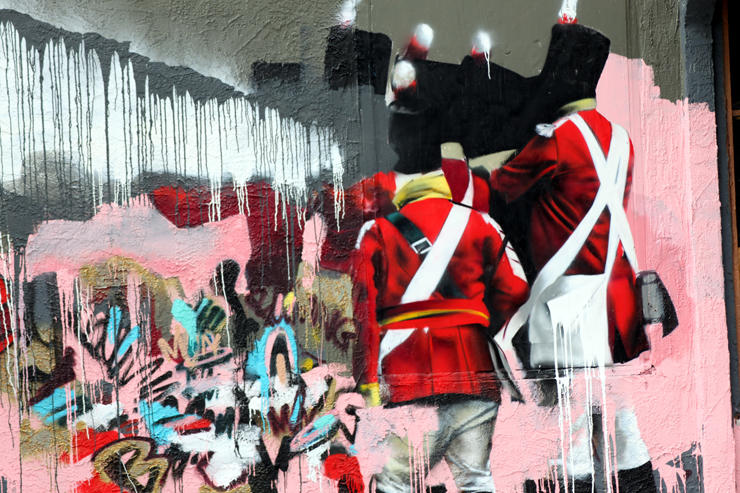
Street Art Photographers: Capturing Ephemera Part 1
 We’ve got a love affair going on right now with everything Street Art. Part of the reason we know so much about it is because we can see images of it on the Internet. And of course in books, magazines, in apps, and if you are lucky, on the street.
We’ve got a love affair going on right now with everything Street Art. Part of the reason we know so much about it is because we can see images of it on the Internet. And of course in books, magazines, in apps, and if you are lucky, on the street.

Conor Harrington © Stefan Kloo
The photographs of a dedicated collection of fans, artists, documentarians, and more casual collectors spread the news all around the globe that there is a multi-lingual vocabulary of art in the public sphere developing almost daily almost everywhere. No one can doubt that photographers have played a key role in making the art form popular, helping make many names on the Street Art scene household names. Pursuing photos and putting them up on their Flickr pages, blogs and elsewhere, these photographers have been instrumental in spreading the word, educating, and generating interest in this art form among ordinary people who would have otherwise never viewed the art on the streets.
With the help of photographers who take their craft seriously and doggedly pursue the art in often off-the-beaten-path locations, an ephemeral history is recorded and preserved like never before. The Street Artists themselves have taken notice of the effectiveness of new platforms for communication and the most savvy of them have adopted new media to effectively promote and advance their work and their careers. Curators in galleries, museums, pop-up shows, myriad art festivals, and cultural institutions take notice of new names through images online and contact artists to offer them opportunities, and instant peer groups coalesce around an ever growing mound of images of work by street artists. Researchers and designers in industries from fashion to textiles to lifestyle to technology all invest time in scouring through photos and collections as resources to glean trends and make products and pitch new schemes. And of course blogs and print publications that are dedicated to documenting and tracking this art form research these growing sources of information for their arts coverage of this emerging movement.

To be sure, there are street art aficionados that have noticed the work of the photographers and are appreciative of the diligence and passion required to go after the art. It is also true that the public still needs a greater awareness of the role that photographers have played in the past and the role that they are playing now.
While many fans of Street Art are very familiar with the artist’s work, fewer are cognizant of the photographers who reliably capture and deliver the images of the work. And why would they? Many images one can see are unaccredited. In fact there is such little regard for the authorship of images that there is a growing practice of populating sites and building a reputation as a curator by simply filching the images without crediting the photographer.

We have asked three of today’s active Street Art photographers; Luna Park, Becki Fuller and Stefan Kloo, to talk about their experiences and opinions to help us illuminate the relationship between Street Art and the photographers that document it. Together they have perhaps 25 years of shooting Street Art, thousands of miles on their kicks, and thousands of hours and dollars spent pursuing and presenting the explosion of Street Art that we have fallen in love with.
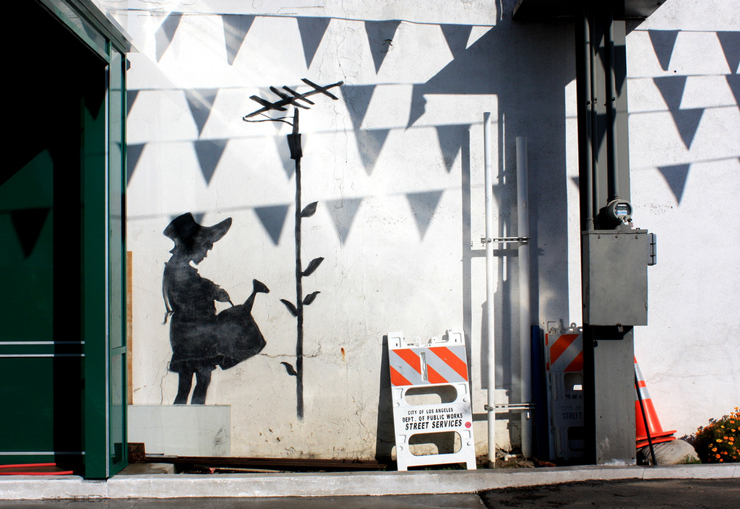
Banksy in Los Angeles © Luna Park
Brooklyn Street Art: You have been documenting Street Art for almost a decade now. How do you view your body of work and its relative importance to Street Art and history?
Becki Fuller: I think that street art is such an immediate and evolving form of expression that it can be easy to forget what an artist did last year, much less three or four or five years ago. Being a street art photographer is a lot like being a historian in that we carefully and thoroughly document the evolution of an artist’s technique and style in a way that would otherwise be lost. Each picture is then categorized and stored away, hopefully used or viewed again in the future. I think that it should be of no surprise that the other two photographers that I am being interviewed with are librarians! But as far as my street art photography collection goes, I have been covering the New York City area for a long enough period of time to amass a pretty comprehensive evaluation of what has been happening here. I don’t necessarily have the time to post or share a good portion of my photographs anymore, but that doesn’t mean that I didn’t take them! For people who are interested in putting together a book or some other project, my collection can, and has been, a good resource. To me, any time my pictures are published, it has the duel importance of helping an artist’s work to live on and to be seen by people all over the world as well as reinforcing the importance of photography (and photographers) in the street art world.
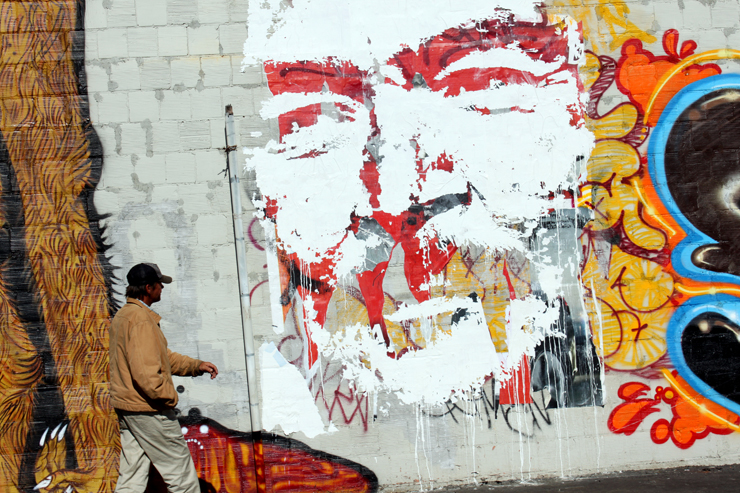
Vhils in San Diego, CA. © Stefan Kloo
Luna Park: Although I’m still a few years shy of having documented for a decade, street art has most certainly played an increasingly important role in my life over the last few years. Chronologically, my introduction to the world of street art coincided with my discovery of Flickr and the two have been inexplicably entwined for me ever since. Coming from a library science background professionally, the organizational possibilities of Flickr intrigued me from the get-go. As I began to amass more and more street art photographs, Flickr provided me with the perfect platform to both present and organize my work. It’s also been an incredible place to learn about street art and connect with the community. Although I never imagined at the time that my photo stream would one day grow to include over 7,500 images in 175 sets, it was my intention to create an archive of street art documentation from the very beginning. As an information professional, the tenets of credible and reliable sources of information are the foundations of my work. In my travels through New York City and beyond, I have sought out what I consider the best of current street art and, to the best of my ability, identified its makers. Enriched by the knowledge of the hive mind and supplemented with lively commentary and analysis from within the community, I believe my body of work has grown to become a well-respected resource.
Stefan Kloo: I feel rather privileged that I got to take these shots. I look at my catalog of photos about the same way I cherish my record or art collection. It’s testimony to my passions, my life in these times and the people I connected to through their work. Just keeping an eye on things, my posts are my mixtapes.
I love going back and looking at photos of older pieces, and it’s a thrill to see the evolution of certain artists, styles or the genre as such, but I’d much rather be surprised by a new piece in the street than looking at photos of those that no longer exist.
I’m convinced that street art is here to stay, so why look back when there’s so much clever beauty around us anytime? To write history, there I said it.
Without the photos, or films for that matter, Street Art would be an anecdote, and I wonder of course how serious we would take it if legend and lore were all that remained.
I love the idea that we were there when that dog and pony show came of age, which I got a good shot and get to tell about it.
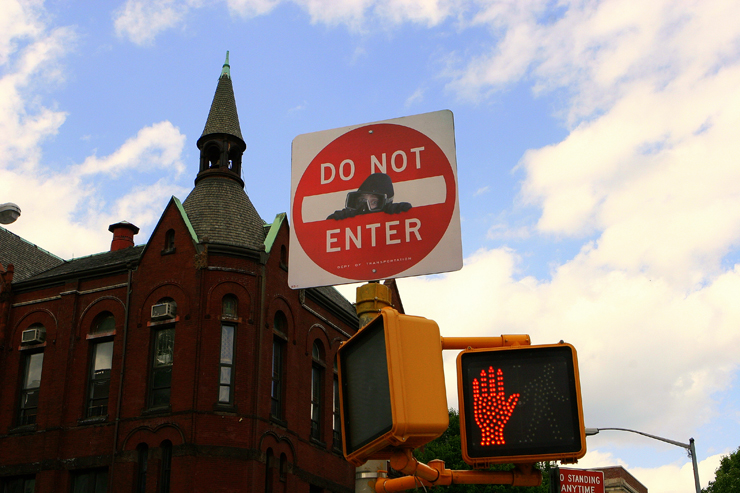
Dan Witz © Becki Fuller
Brooklyn Street Art: Street Art has become very popular across the globe with websites, blogs, week-long festivals, installations, shows in galleries and exhibits in museums. Do you think your work has helped the artists and street art and its popularity?
Becki Fuller: I think that photography – regardless of whose it is – has played an important and necessary role in growing the popularity of street art. If it weren’t for photography, few of us would know much about what’s going on outside of our immediate communities. But because of the images available online and in books, street artists can have a built-in global fan base. It was because of photography that I became aware of what Os Gemeos were doing in Brazil, what A1one was doing in Iran, or what Know Hope was doing in Israel, as I have never been to those countries.
Then there is the ephemeral nature of most street art – if you don’t document it right away, there may never be a chance for anyone to see it again. And realistically, 20 or 30 years down the road; a well-documented body of work is your legacy. Outside of a very small group of aficionados, few people talk about graffiti artists from the 80s who weren’t well documented and I think that the same will be true for street artists in the future.
Luna Park: While I am but one cog in the increasingly big wheel of international street art coverage, of course I’d like to think that my work has been meaningful and had an impact. I’ve been one of NYC street art’s biggest cheerleaders for the past six years, making it my business to hunt down and present the best the scene has to offer in a timely fashion. Through my travels, I’ve had the opportunity to explore the street art of other countries and in turn share these discoveries with others. I’ve developed and maintained close, personal relationships with many artists and fellow photographers, which in turn has enabled me to facilitate connections between artists and introductions to gallerists. I’ve even housed and fed visiting artists, guided them to suitable spots and arranged for wall space – I don’t think it gets any more helpful than that!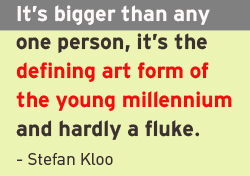
Stefan Kloo: Just as much as every other photo taken, every piece put out there, every gallery show and any other conversation on the topic had – the proliferation of street art is more than the sum of it’s parts. It’s bigger than any one person, it’s the defining art form of the young millennium and hardly a fluke.
I get the nod by the artists or street fiends – that’s got to be enough. Everything else is a bit of a fantasy, nothing that alone would drive this lunacy.
In photographing street art you have to be mindful that without the piece in the street there would be no photo, but that without the photo there may be less incentive to put the piece out in the first place. Yes, in most cases the work in the street is a selfless gift asking little in return than the thrill of putting it there, but consider how much an artist would be willing to invest and risk if there’s never any feedback, no comment on the work, no compliment or critique? If that coveted dialogue in the street becomes little less than shouting in the wood? Would all your creativity and moxy not become stifled or self-indulgent?
It’s that dynamic where the photographers and bloggers come into play – they can be counted on to digest, record and promote the ephemeral efforts of the artists.
Photographers are generally the first responders, reliable observers and quasi curators of the street galleries. The concerted effort to document the art by committed photographers must be an incentive to many artists, knowing that their work will have a much larger audience and longer shelf life. That fosters that dialog that in turn encourages and motivates the artists. It’s the vanity of the vandal that pulls the cart, and the photographer tickles that fancy.
To paraphrase McLuhan – If you talk about street art and the document of it, it always comes in pairs with one acting as the content of the other while obscuring the operation of both.
<<<> > << > < > < > > <<<>>>>>>BSA<<<> > << > < > < > > <<<>>>>>>BSA
Street Art Photographers: Capturing Ephemera Part 2
To see more of Stefan Kloo’s work go here.
To see more of Luna Park’s work go here.
To see more of Becki Fuller’s work go here.
Becki and Luna’s blog The Street Spot is here.
Electric Windows 2010; Street Arts and Community
Sure, there are a lot of things wrong with our country these days. People are hurting financially, are losing homes and jobs, feeling insecure – and obstructionists fight against every possible people-centered bill that comes up in our legislative branch. Our sad legacies of racism and classism are stoked to pit us against one another rather than moving toward an equitable future for everyone. If you were to never go outside and only gathered your news from Yeller TV you might get the worldview that we are in an intractable war with one another. But the State of our Union is on Main Street, not cable.
Main Street in Beacon, NY for example. Electric Windows, the Street Art event put together by the tireless duo Dan and Kalene (owners of the Open Space Gallery) and three other friends, is a prime example of what’s good in our country these days. Appreciation for the creative spirit that lies inside each person brought together a large and a very diverse group of people to this small town on Saturday. Music (live and DJ), street dancers, screen printing on your clothes… Folks were moved, changed, challenged and inspired by the art being made in front of their eyes: Unrestricted, unfiltered and in direct contact with the artists that were creating it.
The day was glorious not only because of the low humidity and breezes up the Hudson Valley but mostly because we had the opportunity to witness the faces of delight of the community while watching the artists do what they love to do most: Paint. Saturday was important to America not because Chelsea Clinton was getting married a few miles north of Beacon but because a whole town literally opened its doors to everyone that wanted to come and make and experience art: Free of charge and uncensored.
We love art and artists of course but when we see people actually enjoying it and supporting it in a respectful and festive environment we are reminded once again that the stories that we are told about ourselves on TV are not often real or true. We are better than we are being told we are. We need to do a better job at getting the word out and at making sure that the good stuff gets reported.

- Chris Stain pays homage to the workers. (© Jaime Rojo)

- It looks beter sitting down. (Chris Stain) (Elbow Toe on the door from last years event) (© Jaime Rojo)

- Kid Zoom installed probing eyes in the windows of a building. (© Jaime Rojo)

- Two generations admiring the work of Elbow Toe (© Jaime Rojo)

- Cern discussing what’s next as the canvasses cascade down Main Street. (© Jaime Rojo)

- If you needed a quiet break from it all, this bucolic site was just a mere feet away. (© Jaime Rojo)

- Anera and Peru Ana Ana Peru prepping for their installation. (© Jaime Rojo)

- Chor Boogie flew in from the west coast to participate. He’ll be in NYC this week. (© Jaime Rojo)

- Gaia (foreground) and PaperMonster (background) and Kim striking a thoughtful pose. (© Jaime Rojo)

- Gaia and Papermonster pieces almost finished. (© Jaime Rojo)

- JC2 Army of One. (© Jaime Rojo)

- The Michael DeFeo piece goes up first, causing an eruption of applause from the crowd on the street. (© Jaime Rojo)

- Peat Wollaeger brought inflatable versions of his signature eye to hang. (© Jaime Rojo)

- An attentive art fan with Ron English piece behind her. (© Jaime Rojo)

-
Joe Iurato. (© Jaime Rojo)
Joe Iurato. (© Jaime Rojo)

- Joe Iurato’s piece goes up. (© Jaime Rojo)

- Measure Twice! Skewville. (© Jaime Rojo)

- Skewville (© Jaime Rojo)

- Front seats to watch Logan Hicks at work. (© Jaime Rojo)

- Sailor Hicks takes his puppet for a march up the tracks. (© Jaime Rojo)
To read BSA interview with Dan and Kalene go here:
Fun Friday 07.30.10
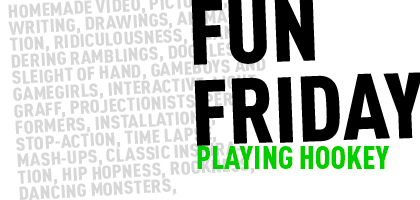
Fun Friday 07.30.10 on BrooklynStreetArt.com
Last Chance to see “Radiant Child” Movie this Weekend at Film Forum
A gem of a film, isn’t that what those old timey movie reviewers used to say? The previously unseen footage of Basquiat shot by his friend Tamra Davis in his studio is probably the most revealing about his short personal history, his meteoric rise, and wild free child within. Less illuminating is some of the self- aggrandizing by those who now lay claim to his history. Equally it is an indictment of a society dealing with it’s legacy of racism, and the misplaced value given to critics with personal agendas. Nonetheless most viewers will understand intuitively the work for what it is and focus on the Brooklyn guy who made it cool to be outside.
Jef Aerosol doing a tribute to Basquiat in Brooklyn earlier this year (photo © Jaime Rojo)
Don Pablo Pedro this Saturday at Pandemic
“Fuck Don Pablo Pedro” is the second solo show for this talented Bushwick painter tomorrow and is sure to be fun, colorful, libidinous, and nauseating. Pandemic Gallery
Brooklyn Street Art duo Faile recently took their sculptural installations to an earlier classical period of the Biennial Portugal Arte 10. The pop culture influences are re-contextualized, as they say….
Electric Windows Tomorrow in Beacon New York
Take the Metro North about an hour up the Hudson to see 30 Street Artists painting live. Is there more to say?
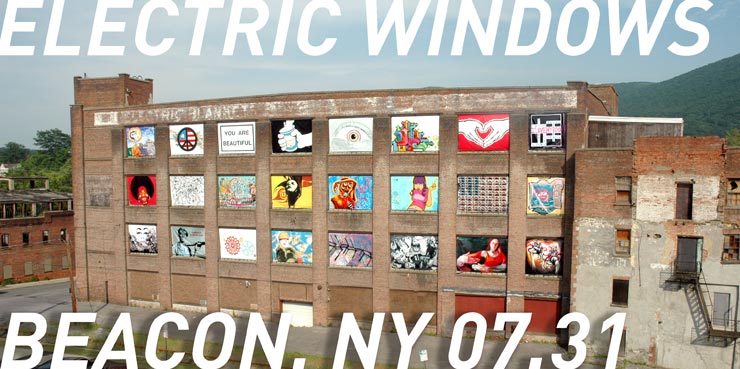
Read about Electric Windows HERE.
A book signing of “Street Art New York” by Jaime Rojo and Steven P. Harrington will be in the Open Space Gallery from 2 pm to 3 pm.
Buxtonia at “Electric Windows”, Ad Hoc in the House
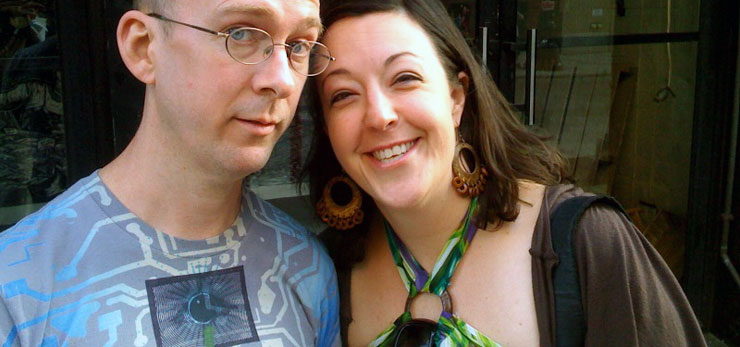
Garrison and Alison Buxton, known together as Buxtonia, continue to carry the spirit of Ad Hoc wherever they are. See them at “Electric Windows” Saturday. (photo © Steven P. Harrington)
Among the many street artists flooding into Beacon for Electric Windows on Saturday will be a couple almost all of them know for their dedication to building and maintaining the community. Godparents to a street art gallery/collective/community in Bushwick, Brooklyn at a crucial time for Street Art in the mid 2000’s, Garrison and Alison Buxton are now on the road across the country 6 months a year continuing their collaboration with the Street Art community. It was a good five year run at Ad Hoc, the gallery, which officially closed late last year, having given many a street artist their first show while creating a sense of connectedness between Street Artists, Graff writers, photographers, screen printers, and social activists who all responded to the high vibrational pull Alison and Garrison created.

For the For the Buxton’s it was never about the hype. She’s full of industry and energy and organizing, while he’s full of a youthful wonder about life and loves to talk with you about social/spiritual movements. Together they have traveled a lot in the last 9 months across the States participating in art shows, re-connecting with friends, teaching screen printing, painting walls, organizing exhibitions, and discussing plans for a sustainable living project at their Vermont farmhouse, an old Buxton family homestead from the 17 & 1800′s. Amazingly, the Buxtons have recently learned that their old homestead was also where one of their favorite modern art forms, screen printing, was brought to life by a man named Harry Shokler, who lived and worked at the home & studio for over 40 years. Shokler is referred to as father of contemporary screen printing, a seminal figure in bringing screen printing from the world of industrial application to being accepted and recognized as a distinct fine art form. When you speak with either one of them for more than a few minutes you’ll learn they both sincerely believe we are here to share, learn, and teach lessons to each other and that now is time to do so.
Saturday Garrison and Alison will be making art at Electric Windows, and talking to friends about how to bring about the better world that is possible.
Brooklyn Street Art: How long has Buxtonia been working as an entity?
Garrison Buxton: I actually used Buxtonia as the title of my first website in like 2002/3. Alison and I have referred to it as a state-of-being for years, with our first Buxtonia mural manifesting in Peru in 2008. It has been coming into being for a while now and it seemed natural that we start referring to the works we did together as such. We did Buxtonia murals with Broken Crow in Minnesota in 2009, and with NOLA Rising in New Orleans in 2010.
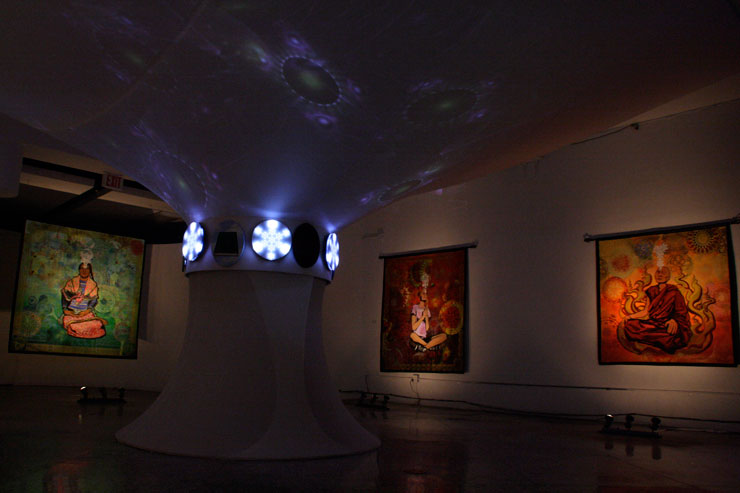 The installation for Unified Love Movement included a structure that arched in four directions and cast light from the center that emulated the patterns in their paintings on the ceiling. (Buxtonia)
The installation for Unified Love Movement included a structure that arched in four directions and cast light from the center that emulated the patterns in their paintings on the ceiling. (Buxtonia)
Our first gallery work that I currently recall using Buxtonia was in October 2009 for an installation we did in Oklahoma called:
Buxtonia {Garrison & Alison Buxton}, Unified Love Movement
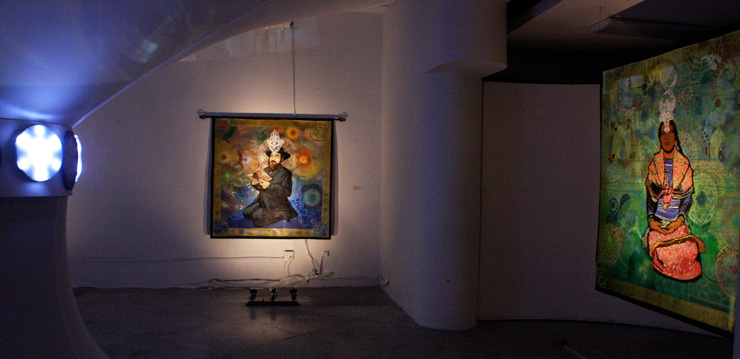
Installation from “Unified Love Movement” by Buxtonia, a meditation and commentary on the worlds’ major belief systems, their interconnectedness, and a global awareness of spiritual themes.
BSA: Your work is layered and multi-dimensional – can you describe a typical process you two go through in creating a piece?
Garrison Buxton: Firstly, we come up with what the vision of the piece is, laying out and building the compositional aspects like imagery, arrangement, aesthetic, layers, and forms. After we have that in mind, then comes breaking it back down to the base and working up each of the aspects. Construction, Deconstruction, Reconstruction, on and on… After priming, we start out with washes and/or gradients to unify the background, then we build out light & dark areas based on the piece’s color palette. Once the background is built up, we then use layers of stencils to create textures and develop areas of light & pattern. We incorporate screen printing as well, either directly on the surface or via collage. Using hand painting and drawing helps to bring in the upper layers. Certain aspects are predetermined, like a border design, but building up the stencils and textures is a very participatory and engaged process. The action of assembling the pieces to the puzzle encourages reflection, dialogue, and feedback. It is a dialogue with all of us, humans, materials, and the voice of the work. We change with each other. Every piece is that moment’s exploration into human interaction and relationship.
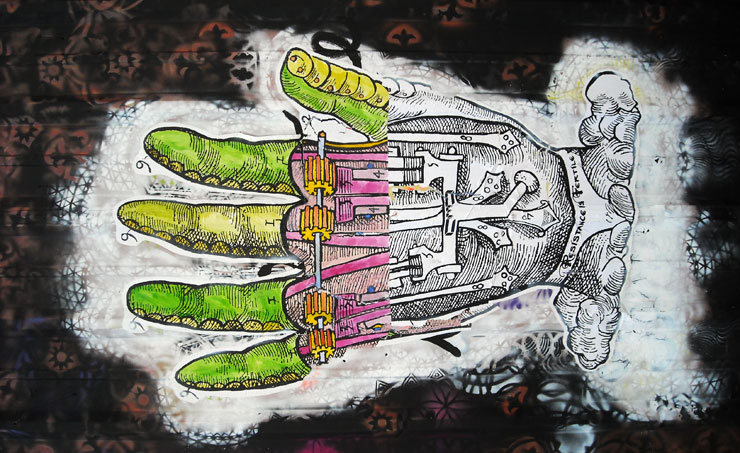
“Resistance is Fertile”; a mechanized hand combines industrial revolutionary diagrammatic style with a surreal zeal of modern possibility. The piece repositions the struggle of the worker in a future context. From a mural done with NOLA Rising (Buxtonia)
BSA: Where do you draw upon for inspiration thematically?
Garrison Buxton: The core of it for me would be that we are all part of the same thing, the singularity and inherent oneness of existence. Until we truly get that, we are not making real progress. There is a lot of misery being generated by the intention of a select minority on this planet enabled by the masses of under-informed. Most days, the urgency of our times inspires me to maintain a sense of peace in a world run by sociopaths gone utterly mad. I have a hard time believing that we are destined to go out this way, like a stupid rampaging beast, smashing to bits anything and everything in our path as we careen over the cliff. Another world is possible in every instant. The power to share, to contribute, to change is abundant and always around us.
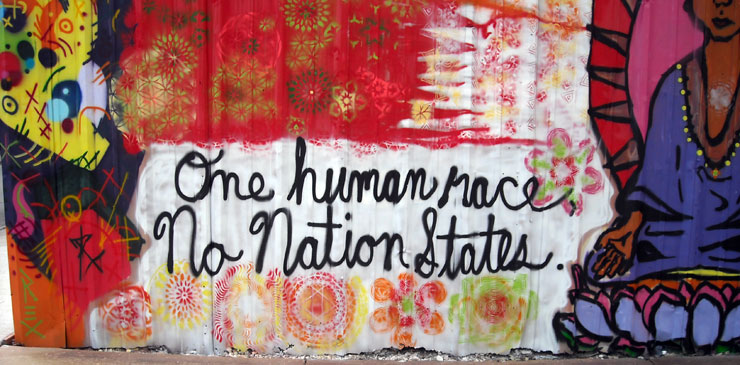
BSA: For both Willoughby Windows in Brooklyn and Welling Court Queens also participated as artists. What about being in these group shows is gratifying to you?
Garrison Buxton: Bringing creativity and beauty to people directly is very fulfilling. It is one of the most unfiltered ways to bring art to a culture largely starved of non-corporate, non-advertising-generated media. One of the fundamental aspects of street art is the democratization of public space. Maybe it is all an illusion, but it is fulfilling to believe in the power of art to create, inspire, and plant seeds of observation as well as shared experience. People relating to one another is what will get us to the other side. People fearing one another will not. Relating comes when people take the time to simply do it, relate. Seeing the direct results of these art projects has been profound and definitely inspires us to keep taking things to the next level. The bonds that result from bringing generations of different peoples together for a celebration of the human experience are so strong. Together we can do amazing things. I have seen it.
BSA: What are you planning to show the people at the Electric Windows show?
Garrison Buxton: We have been working with a figure, Metatron, for a while now. Metatron is typically depicted as a eye with wings. The Electric Windows piece is going to have a small flock of Metatrons flying up on the horizon with rays and shapes of light emerging from behind.
Is the loosest of senses, Metatron is the messenger of the divine, translating the beyond-human transmissions to be human-comprehensive. I believe we are all Metatrons, our own divine messengers, and that we all transmit this divine information to our selves and each other. When we are still and listen to that part of us that existed before we can remember existing, the knowledge we seek is there. We are all self contained enlightenment, divinity, god, whatever you want to call it. How to illustrate that is the never ending pursuit. It has become important for us to focus on sending positive transmissions. We aim to send a net positive charge into the matrix. The grid is cracking. It needs all of our help. This piece depicts the strength of coming together and building something with a whole greater than the sum of its parts.
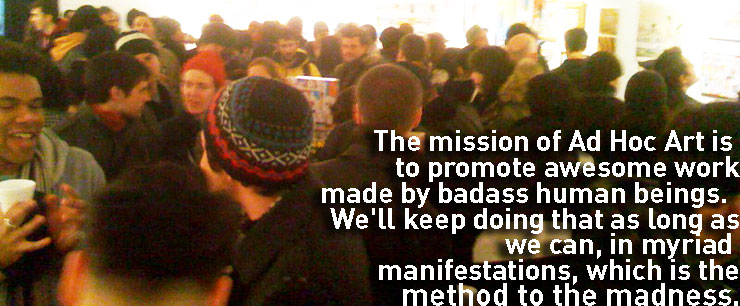
BSA: How has your life changed for both of you since leaving Ad Hoc?
Garrison Buxton: For clarity’s sake, we never left Ad Hoc, as Ad Hoc Art still exists as an entity and we are still doing art events and projects like the previously mentioned Willoughby Windows and Welling Court projects as well as currently featuring many AHA artists with us in a screen printing project at SummerStage in Central Park through September. The mission of Ad Hoc Art is to promote awesome work made by badass human beings. We’ll keep doing that as long as we can, in myriad manifestations, which is the method to the madness. On the front burner is a fall/winter tour where we will be working with artists across the country, many of which we worked with at Ad Hoc, as well as artists we have worked with since then.
So, I’m assuming that you are referring to how have our lives changed since moving out of Bogart St, yes? That question is an expansive one, so many changes happening in so many ways. Like any era in a relationship coming to a close, it is largely in how one perceives it. Boiling it down, there are times we’re missing the great times, all the magic; we’d wish we were still making a difference in the Bushwick hood and wonder if there were somehow an angle we didn’t think of that could have kept the hull together. Then we quickly remember how working 18 hour days for years takes it toll, how there were days of stress and frustration, and how five years flew by in the blink of an eye and I hadn’t seen some good friends in years. Overall, we are much healthier and happier and realize we are blessed to have the opportunities that we have and don’t look back. There is so much to be accomplished now, more so than ever. We are still working crazy hours, but in a way that serves us better and is sane. We are operating at a more tenable, sustainable pace, training and running with a marathon mindset for a race of enduring as opposed to the frenetic burst of the 100 yard dash. Short term focus will not get us to the other side. Thinking beyond ourselves will get us there.
Some things we are loving: working our own creative endeavors/projects; less daily stress; the ability to be more dynamic and mobile (we’ll be on the road about six months of the next year, taking art love coast to coast and doing projects with people in places we never had time to visit before); more time to be human; & more time to work on altruistic projects. Basically, we have a lot more time to take care of ourselves, spiritually, mentally, and physically. As everything emanates from within, if the core is not stable, all that comes out contains that fundamental lack of stability. In taking time to be, we saw an immediate and direct positive return which correlates directly with overall happiness.
BSA: Any advice for people who are planning to go to Beacon for the show?
Garrison Buxton: Bring sunscreen and drink lots of water. Beacon is a nice lil’ town and the show is going to be awesome event. Open Space again delivers a solid roster of fun. We are excited to be working with some of our favorite partners in crime and a whole slew of new peoples. Plan on staying late Saturday night if you like to dance. Bring clothes if you’d like to have them printed. We are going to be screen printing live and dropping some brand new images that Saturday.
We love you.
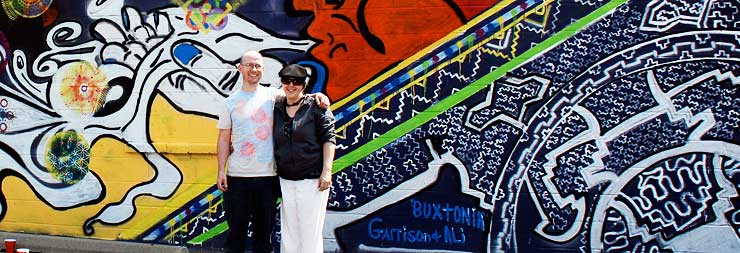
Electric Windows will feature Buxtonia, BoogieRez, Chris Stain, Depoe, Elbow Toe, Mr Kiji, Michael De Feo, Peat Wollaeger, Rick Price, Ron English, Big Foot, Cern, Chor Boogie, Chris Yormick, Elia Gurna, Erick Otto, Eugene Good, Faust, Gaia, Joe Iurato, Kid Zoom, Logan Hicks, Lotem & Aviv, Paper Monster, Ryan Bubnis, Ryan Williams, Skewville, and Thundercut
A book signing of “Street Art New York” by Jaime Rojo and Steven P. Harrington will be in the Open Space Gallery from 2 pm to 3 pm.
Some things we are missing: seeing all the wonderful people that were a part of our Bogart St. existence, from the daily regulars to the stroll-ins showing up from all over the world to check out what was going on; all the wonderful things that can happen with having a space, like supporting and fostering community, facilitating people relating with one another, and providing a platform for diverse creative forms to manifest. It was a true pleasure to see all of the things that came out of having that space, a true nugget of fun, and a moment in time I wouldn’t trade for anything. We learned so much and met so many phenomenal people from all walks of life. Literally a life altering experience.
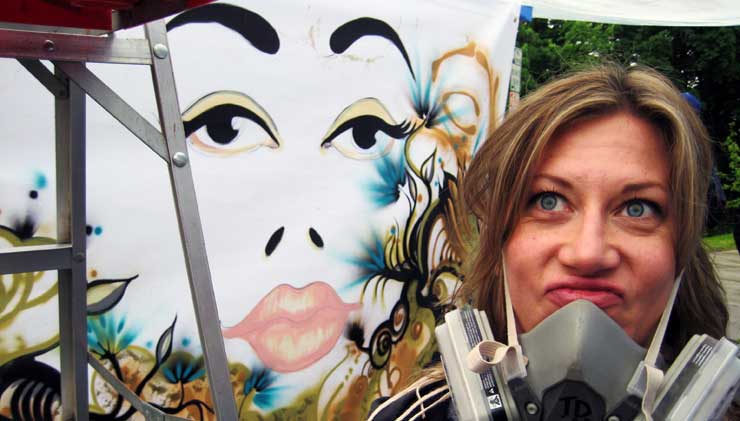
Electric Windows: Thundercut and Street Art in “North Brooklyn”
Together with new neighbors and old friends from back in the city Thundercut are steadily creating a cultural festival built around one of their first loves: Street Art.

The Street Art couple known as Thundercut are not the first Brooklyn artists to head to Beacon, New York, a picturesque phoenix on the Hudson River 59 miles north of Grand Central Station. Kalene Rivers and Dan Weise are just two of the most visionary and fun to talk with.
Once a town known for it’s hat making, Beacon (pop. 16,000) had a reputation as a sketchy drug and crime ridden place when Dan and Kalene were growing up in the Hudson Valley during the 80s and 90s. When the Dia Arts Foundation (also of Dia:Chelsea in Manhattan) renovated a 34,000 sf former factory in Beacon to create Dia:Beacon and to house a collection of Warhol paintings, hulking Richard Serra sculptures, and fluorescent Dan Flavin monuments, among other post 1960 art, interest grew in the town and an artist community largely from New York began to blossom. Many of the original artists who had brought a bohemian caché to rundown neighborhoods like Williamsburg, Greenpoint, and Red Hook in Brooklyn relocated to Beacon as their neighborhoods blanded in the mid 2000s. Much like those original artist enclaves, Beacon has become home to artist collectives, house parties, and experimentation.

Tina Darling poses in front of her work at Electric Windows (all photos courtesy and copyright of Thundercut)
While DIA was an important catalyst when it opened in 2003, Dan says the new residents brought a creative community that grew organically in it’s own direction.
“The people that have moved here have a very DIY spirit and have created something very special that continues to reinvent itself each year,” says Dan. In addition to Dan and Kalene opening their own gallery, Open Space, which shows fine art by many friends and artists in the street art scene, they recount inititiatives by neighbors who organize live concerts, have annual open studio events, host drawing nights at home, and began non-art related groups like soccer and ping pong clubs. Open Space itself has hosted a series of comedy nights that play to packed houses.
Says Dan, “If someone sees something missing in the community, they try to make it happen.”
Begun as a place to house their graphic design business, Open Space took root as a gallery and a community gathering spot. Explains Kalene, “We are both very passionate about giving something back to the community, from bringing new artists to show in the gallery, to organizing events like Electric Windows, these are things that we think are great and we are excited to share them with the town.”
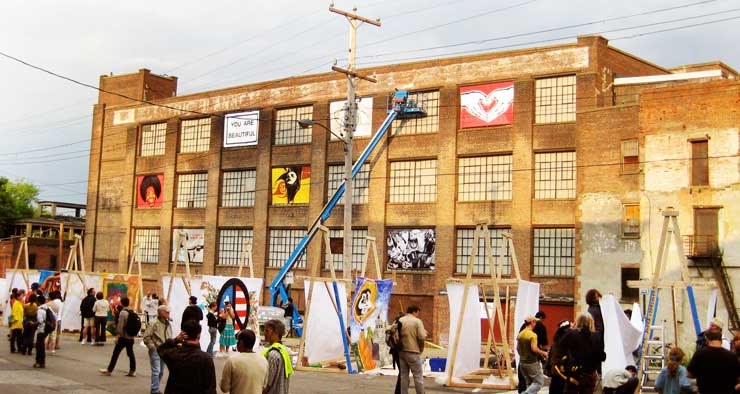
Which brings us to the third year of Electric Windows, a project that fills the eyes of a moribund electric blanket factory with new canvasses painted live on the street by artists while the public mills about. Now in it’s third year, with thirty artists, three buildings and live performances, EW is organized with their neighbors Jon Miles, Jeff Ashey and Nicole Romano. With support from the mayor, a grant from the county arts council, donations from businesses of supplies and money, and even neighbors who are opening their homes to house the visiting artists, Electric Windows is thoroughly a community celebrating the creative spirit and the talent of Street Artists. The artists are traveling from Australia, Portland, San Francisco, St Louis, Milwaukee, New Jersey, and of course, Brooklyn without compensation and are all doing it for the love of the project.
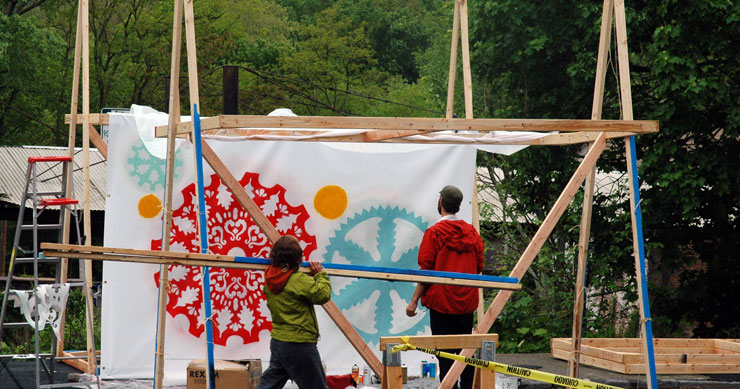
Thundercut at work against a backdrop of lush Hudson Valley trees (© Thundercut)
![]()
Brooklyn Street Art: How did the Electric Windows project first develop?
Dan Weise: The Electric Windows building is what we see when we look out of the windows of Open Space. It is a beautiful turn-of-the-century factory building which, when we first got the space, still had the partially broken glass windows in the frames. It was a postcard for urban decay and having just moved up from Brooklyn, felt like home. Shortly after we opened the gallery, the owner removed all the glass and installed grey plywood window protection in its place. This was far from an improvement in our opinion, so we started discussing what could be done to bring life back to the building. This is when we began seriously talking about the idea of “Electric Windows”.
Our neighbors at the time, an art store named Burlock Home, really loved the idea and were on board to help make it happen. The four of us teamed up and put the whole project together in three months.
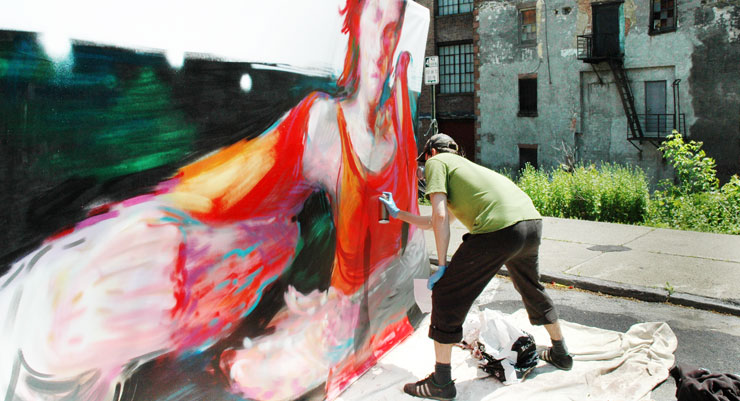
Brooklyn Street Artist Elbow Toe returns this year to Electric Windows (© Thundercut)
BSA: This year features 3 buildings, instead of one. Do you have enough artists?
Kalene Rivers: We are excited about expanding the project to include more locations in the same area and all surfaces are accounted for. Everyday we think about how lucky we are to know so many incredibly talented artists and we just keep meeting more and more. Not only are they talented but they are amazing friends willing to donate their time and talents to events like Electric Windows for the love of making art and supporting positive projects.
![]()
BSA: Street Art is normally associated with large metropolitan areas. How does Beacon fit in to the equation?
Dan: Historically, Beacon was a town of manufacturing and the evidence still remains. There are some really phenomenal factories here in town, some vacant, some in the process of renovations and others like the Nabisco Factory, which now houses DIA, have been transformed into something new. I think this helps bring a bit of an urban feel to a quaint little upstate town. Also, when we moved up here we realized that not many people even knew about Street Art. This being the something that we are both very passionate about we wanted to open the gallery and share this world with people beyond the Bronx. Open Space Gallery was formed, Electric Windows was conceived, and slowly the infiltration has begun!
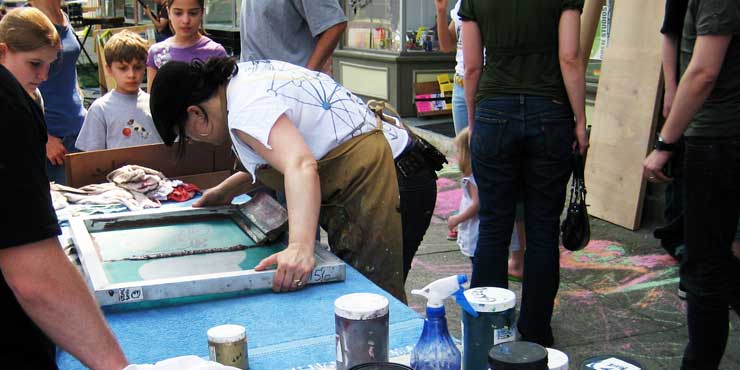
Alison from PMP shows kids how to screenprint (© Thundercut)
BSA: Would you say most of these artists are Street Artists? Or are there also graffiti artists, fine artists….
Kalene: I would say that most of the artists are Street Artists but there certainly is a good group of graffiti and fine artists in the mix. Of course the first people we think to invite to the project are friends. Being involved in the Street Art scene for seven years means that these are the people we know best. However, it is wonderful to work with a variety of people from different backgrounds. The artists have to be able to paint big and fast so our selection of qualified participants is pretty limited to a certain kind of artist.
![]()
BSA: What’s your favorite part of the event?
Dan: Well, after we stress out for months planning and trying to take care of all the details, it is great to look up and see it all in action. Music filling the air, fumes wafting by, people admiring the amazing murals being created, children laughing and dancing. That is when it feels like it has all been worth it. But the event is just the beginning once the crowds leave and the art has been installed the projects gives back to the community, to visitors and to us each and every day.

Returning Artists for Electric Windows: Buxtonia, BoogieRez, Chris Stain, Depoe, Elbow Toe, Mr Kiji, Michael De Feo, Peat Wollaeger, Rick Price, Ron English
New Artists for 2010: Big Foot, Cern, Chor Boogie, Chris Yormick, Elia Gurna, Erick Otto, Eugene Good, Faust, Gaia, Joe Iurato, Kid Zoom, Logan Hicks, Lotem & Aviv, Paper Monster, Ryan Bubnis, Ryan Williams, Skewville, Thundercut
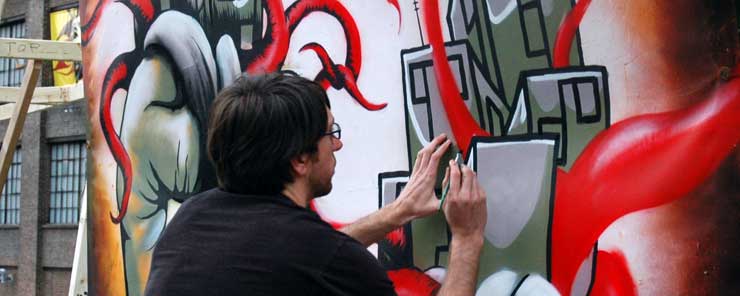
Daryll Peirce at Electric Windows (photo © Thundercut)
This year’s event, which includes two days of preparation by the artists, a one-day exhibition and street fair, music and dancing by M*POWER ELITE TEAM, live screen printing by Buxtonia, and an Open Space after-party, is expected to draw approximately 5,000 people to Beacon’s Main Street corridor.
The line-up of live music at ELECTRIC WINDOWS includes: Ben Neill, Aabaraki, Hart Costa, DJ Birds in the Building, DJ Bobby Collins, DJ Krisis, Dr. Ambassador, Gold Monkey, and Scambler Seequill.
Electric Windows (Beacon, NY)
Participating artists include: Avic Tchernichovski, Big Foot, Buxtonia, Cern, Chris Stain, Chris Yormick, Depoe, Elbow Toe, Elia Gurna, Ellis G, Erik Otto, Eugene Good, Faust, Gaia, Joe Iurato, Mr Kiji, Logan Hicks, Michael De Feo, PaperMonster, Peat Wollaeger, Rick Price, Riiisa Boogie, Ron English, Ryan Bubnis, Ryan Williams, Skewville, and TC.
Welling Up a Little? That’s the Street Art “Community” Feeling
Welling Court Mural Project Opens Over the Weekend in a Queens Community; Many Street Artists Contribute
There can be a bit of grand posturing around the word “community” especially by people (or corporations) who spend more time chasing the Gravy Train than climbing on the Love Train. And swimming in an acid-tongued media landscape that keeps saying we’re are a giant polarized society simply bubbling with animosity, you could be forgiven for not leaving your house, let alone breaking bread with your neighbor who is different.
New York people prove that lie to be wrong every day – we are a hugely diverse lot- our different mother tongues alone could lick a frosting bowl the size of Shea Stadium. And yet mysteriously all of us weird different kinds of people are all getting along with each other day after day – sometimes we even enjoy each other!
Welling Court Murals, a project with Street Artists in a neighborhood in Queens, New York, came to fruition on Saturday and the results were as colorful and eclectic as we are. While the people on the block barbecued and danced and played games, kids chased each other and rode their bikes and took many pictures of Street Artists doing their thing on the walls- spray cans, paint brushes, wheat paste, and markers busy.
Saturday was the “show day” for this project that the folks at Ad Hoc Art, with Alison and Garrison Buxton at the helm, have been “community organizing” for a long time. However, by no means is it the end of the project, as new friendships and alliances were forged and a neighborhood has a new panoply of street art to look at, ponder, and hopefully be inspired by.
The Welling Court Mural Project was one of the most cohesive “community” events we’ve seen in a long time. Street Artists plus an engaged neighborhood of very nice people… delicious home-made foods, music from Latin America and India/Pakistan, adults, kids, painting, asking and answering myriad questions, posing for pictures in front of pieces — all proving again that the arts can bring people together. A sincere “Thank you” to Ad Hoc and Allison and Garrison and all the artists for putting your best out there for others to share.
Welling Court Artists include: Alice Mizrachi, Beast, Chris Mendoza, Chris Stain, Celso, Cern, Cey Adams, CR, Cycle, Dan Witz, Darkclouds, Daryll Peirce, Don Leicht, Ellis G, Free5, Gaia, Garrison & Alison Buxton, Greg Lamarche, JMR, John Fekner, Lady Pink, Leon Reid, Matt Siren, M-City, Michael De Feo, Mr. Kiji, Pablo Power, Peripheral Media Projects, R. Nicholas Kuszyk, Remi/Rough, Ron English, Royce Bannon, Sofia Maldonado, Stormie Mills, Sweet Toof, Swoon, TooFly, Tristan Eaton, and Veng RWK.
JMR’s got his Piece done for the Queen’s Wall
No, not Queen Elizabeth, – it’s the borough of Queens this time.
Ad Hoc Art, with the Queen Alison Buxton and her ever-loyal servant Garrison at the helm, are putting together a very fun and expansive show on the walls on Saturday. We know the list, and there are a couple special guests, so don’t miss it. It’s kind of far, but it will be worth it when you get there.
Welling Court Artists include: Alice Mizrachi, Beast, Chris Mendoza, Chris Stain, Celso, Cern, Cey Adams, CR, Cycle, Dan Witz, Darkclouds, Daryll Peirce, Don Leicht, Ellis G, Free5, Gaia, Garrison & Alison Buxton, Greg Lamarche, JMR, John Fekner, Lady Pink, Leon Reid, Matt Siren, M-City, Michael De Feo, Mr. Kiji, Pablo Power, Peripheral Media Projects, R. Nicholas Kuszyk, Remi/Rough, Ron English, Royce Bannon, Sofia Maldonado, Stormie Mills, Sweet Toof, Swoon, TooFly, Tristan Eaton, and Veng RWK.
Read more about Welling Court Mural Project HERE
Images of the Week 05.16.10 on BSA
Our Weekly Interview With the Street
Artists participating are Aakash Nihalani, Billi Kid, Blanco, Cake, Celso, Cern, Damon Ginandes, Darkcloud, David Cooper, Elbow-Toe, James and Karla Murray, Joe Iurato, Matt Siren, NohJColey, Peru Ana Ana Peru, Skewville, Sofia Maldonado, Stikman, UR®New York and Veng.
Our weekly interview with the street, this week featuring Aakash Nihalani, Billi Kid, Blanco, Cake, Celso, Cern, Damon Ginandes, Darkcloud, David Cooper, Elbow-Toe, James and Karla Murray, Joe Iurato, Matt Siren, NohJColey, Peru Ana Ana Peru, Skewville, Sofia Maldonado, Stikman, UR®New York, Veng, Faile, Shepard Fairey, Various & Gould, Ron English,Mr. Kern, DAIN, and Primo.
 BROOKLYN STREET ART LOVES YOU MORE EVERY DAY
BROOKLYN STREET ART LOVES YOU MORE EVERY DAY